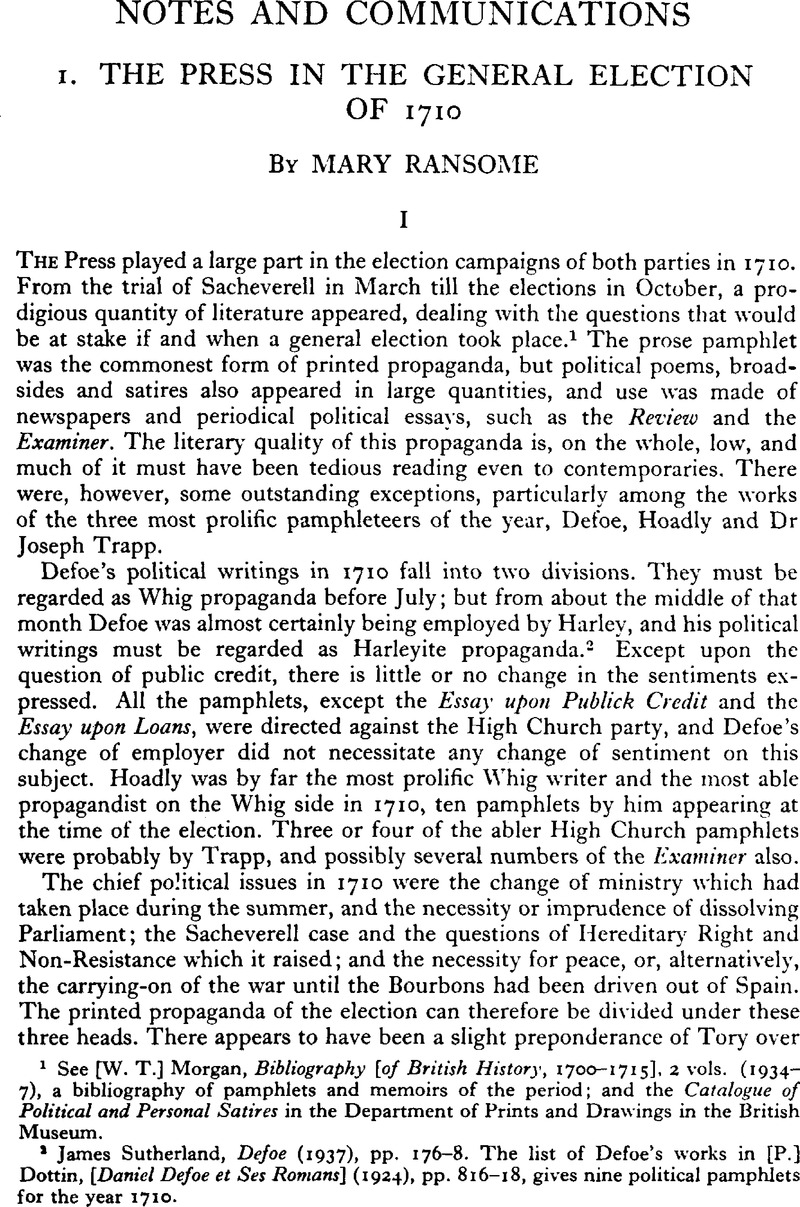Article contents
1. The Press in the General Election of 1710
Published online by Cambridge University Press: 20 December 2011
Abstract

- Type
- Notes and Communications
- Information
- Copyright
- Copyright © Cambridge University Press 1939
References
1 See [W. T.] , Morgan, Bibliography [of British History, 1700–1715], 2 vols.(1934-7)Google Scholar, a bibliography of pamphlets and memoirs of the period; and the Catalogue of Political and Personal Satires in the Department of Prints and Drawings in the British Museum.
2 Sutherland, James, Defoe (1937), pp. 176–8Google Scholar. The list of Defoe's works in [P.], Dottin, [ Daniel Defoe et Ses Romans] (1924), pp. 816–18Google Scholar, gives nine political pamphlets for the year 1710.
3 [J], Oldmixon, Life [and Posthumous Works] of [Arthur] Maynwaring (1715), p. 158Google Scholar.
4 The Parallel, a poem. B[ritish] M[useum] Add.MS. 23904 (a collection of poems printed in Anne's reign), f. 72V. Cf. also The Virtues of Sid Harriet the Magician's Rod (1710)Google Scholar, attributed to Swift. The date of all the pamphlets cited below is 1710, unless otherwise stated.
5 The Beasts in Power: or Robin's Song (1709). A poemGoogle Scholar.
6 The Blackbird's Tale: A Poem (price 2d.) and The Blackbird's Second Tale. For other poems, many of them set to the music of popular songs, see A Pill to Purge State Melancholy (1715), a collection of Whig ballads, many of which originally appeared in 1710.
7 The British Museum catalogue gives three editions in 1710. Two answers appeared:
(i) The Impartial Secret History of Arlus, Fortunatus and Odolphus (price 6d.), reprinted in 1710 as The Second Part of the Impartial Secret History etc.
(ii) Animadversions upon, or an Impartial Answer to the Secret History of Arlus and Odolphus… (1711, price 4f.).,Google Scholar
8 A True and Faithful Account of the Last Distemper and Death of Tom WhiggEsq., who departed this Life on the 22nd Day of September last, Anno Domini 1710 (2parts)Google Scholar.
9 Attributed in the British Museum catalogue to Charles Hornby. Further parts appeared in 1712 and 1713.
10 On this cf. also The New Scheme Consider'd (price zd.).
11 Review, vii, No. 61.
12 H[ist.] M[SS.] C[omm.] Portland, iv, 585.
13 A Letter to Isaac Bickerstaff Esq. occasioned by the “Letter to the Examiner”.
14 The Fears and Sentiments of all True Britains; with respect to National Credit, Interest and Religion. Cf. also A Letter of Advice to the Freeholders of England and The Election Dialogue, also by Hoadly.
15 Seldom Comes a Better (price 2d.).
16 This point of view was expressed in a poem, Belisarius and Zariana (i.e. the Duke and Duchess of Marlborough).
17 Carte MS. (Bodleian) 125, f. 98. The writer was a Jacobite.
18 There are various lists of contemporary literature dealing with the trial. In addition to Madan's, F.Bibliography of Sacheverell, Dr Henry (1884)Google Scholar, there is a list of pamphlets on the subject in the library of St Paul's Cathedral, compiled by Sparrow-Simpson, W. in Notes and Queries, 6 Jan. 1894Google Scholar, which contains a few titles not included by Madan; and a list of Sacheverell satires, not given by , Madan, in the History of Selattyn byGoogle ScholarBulkeley-Owen, Hon. Mrs in Proceedings of the Shropshire Archaeological Society, Series II, vol. 8 (1896)Google Scholar. The present article mentions only a few of the most important pamphlets, and a few poems not included in any of the above lists.
19 Hymn to the Scaffold in Westminster Hall.
20 B.M. Add. MS. 23904, ft. 81–94.
21 The Tacking Club; or Dr Sacheverell and his Bulleys.
22 Honest Clodd's Advice to his Countrymen… (price id.).
23 The Officers' Address to the Ladies (price id.).
24 Fair Warning (price id.).
25 The Modern Fanatick, Parts I and II, by Bisset. Part II is an answer to A Vindication of Dr Henry Sacheverell, which is itself an answer to Part I.
28 It is attributed to Walpole by Coxe and by Horace Walpole. Oldmixon attributed it to Arthur Maynwaring in his Life of Mayntcaring, but Horace Walpole denied Maynwaring's authorship, “though he sometimes revised Mr Walpole's pamphlets”. Catalogue of Royal and Noble Authors (1806), iv, 198Google Scholar.
27 B.M. Harleian MS. 6233. Printed in 1710. Cf. also A Modest Answer to the Four Immodest Letters to a Friend in North Britain (price id.).
28 It is only possible to mention a few of the many pamphlets on this subject, but the extent of this revival of interest may be judged from the extraordinary popularity of the Populi, Whig pamphlet Vox, Dei, Vox, or True Maxims of Government (1709)Google Scholar, attributed to Defoe, but not included in Dottin's list of his works. Eight editions of this pamphlet appeared in 1710, and a 9th in 1713. It was reprinted in 1710 under the title The Judgment of Whole Kingdoms and Nations concerning the Rights, Power and Prerogative of Kings and the Rights, Privileges and Properties of the People. This work is attributed to Somers in the British Museum catalogue, which gives a 6th edition in 1710, an 8th in 1713 and an 11th in 1714. The pamphlet was answered by An Appeal to thy Conscience, as thou wilt answerit at the dreadful Day of Judgment…, a reprint of the pamphlet of that title by Edward Fisher published in 1643. The 1710 edition had a new title-page, on which it was described as “an unanswerable answer to a late Pamphlet entituled Vox Populi”.
29 Reasons against Receiving the Pretender, &Restoring the Popish Line (price id.), By , HoadlyGoogle Scholar.
30 A Word against a New Election (October 1710).
31 Cf. also A Second Test Offer'd to the Electors of Great Britain (price id.);Defoe A Speech without Doors (price 2d.); and A Letter to Sir J(acob) B(anks)…, by William Benson, Whig M.P. for Shaftesbury in 1715. The British Museum catalogue gives an 11th edition of this pamphlet in 1711, and also an edition in French.
32 [, J.] Swift, [Prose] Works (ed. Scott, Temple), ix, 219 (Examiner, No. 34)Google Scholar. For the moderate Tory point of view, cf. also The Thoughts of an Honest Whig, upon the Present Proceedings of that Party, and The Declaration of an Honest Churchman, upon the occasion of the Present Times (price 2d.).
33 Onslow, in a note to , Burnet, attributed it to “one Clements, under the direction of Mr Harley” (1833 ed. vi, 14).Google Scholar, Boyer also described it as “written by Mr Clements” and “said to be countenanced by some great men” (Political State of Great Britain, 2nd ed. 1, 49)Google Scholar. Clements “had been a sort of merchant or broker, and was for that performance of his, prefer'd to be secretary to the Earl of Peterborough. His pamphlet had a prodigious run” (, Oldmixon, Life of Maynwaring, p. 171)Google Scholar. The authorship of the pamphlet was discussed in two numbers of the Medley, where the author was described as “a small jobber of new England”. This appears to refer to , Clements (Medleys for the Year 1711, pp. 51 and 206)Google Scholar. In the 2nd edition of Somers Tracts, the pamphlet is attributed to “Richard” Harley, with the additional note that it may be by Defoe, but it is not included in Dottin's list.
34 Faults in the Fault-Finder. Medley, No. 1 (5 October).
35 Most Faults on One Side. Attributed to Trapp.
36 Cf. A Supplement to the Faults on Both Sides, attributed to Defoe by , Dottin; and Faults on Both Sides: Part the Second (5 December 1710)Google Scholar. There is a surprising note to the latter pamphlet in the 2nd edition of Somers Tracts, to the effect that “this pretended Second Part is from an author of opinions very different from those of the originalwriter”, and is “to be considered as an answer” to Faults on Both Sides. It is, in fact, a continuation of the arguments of the first pamphlet.
37 Attributed to Defoe by Dottin.
38 B.M. Add. MS. 22640. The song is printed and stuck on the back cover of the volume.
39 Considerations on Peace and War, Preface.
40 If (…), a Ballad. The title of the British Museum copy is mutilated.
41 On this cf. , H.M.C. Portland, iv, 575. (R. Monckton to Harley, 23 August 1710.)Google Scholar
42 Nos. I, 2 and 3. These are in answer to a pamphlet called A Letter from Monsieur Pettcumm to Monsieur Buys, which I have not been able to find either in the British Museum or the Bodleian. It is, however, given in Morgan's Bibliography.
43 A Letter from a Foreign Minister in England to Monsieur Pettcumm (price 2d.). This pamphlet is attributed to Robert Walpole in Halkett and Lang, the catalogues of the British Museum and Bodleian, and in Morgan's Bibliography, and was originally included by Horace Walpole in the list of his father's works in A Catalogue of Royal and Noble Authors. Coxe, however, has pointed out the improbability of this attribution. “I have reason to think this pamphlet was not written by Sir Robert Walpole, as it is a vindication of the Tories. Probably he might have written an answer.” He added that Horace Walpole “candidly acknowledged that he might have been mistaken”. A note to this effect was added to the 1806 edition ofRoyal, , Authors, Noble, iv, 197Google Scholar(Coxe, W., Memoirs of Sir Robert Walpole (1798), I, 752n.)Google Scholar.
44 Reasons Why the Duke of Marlborough cannot lay dozen his Commands… (10 August 1710)Google Scholar.
45 It is interesting to note that whereas in July Gaultier thought the impending changeswould make little difference to France, by the end of August he believed that as soon as the changes were complete, the Queen would indicate to the Dutch that she was tired of the war, that Townshend would be recalled and Marlborough dismissed. (B.M. Add. MS. 34493, ff. 2 and 6r.)
46 Reasons Why a Certain Great General has not yet Receiv'd the Thanks of eitherthe Two Houses of Parliament (price 2d.).
47 , Swift, Works, ix, 71–7. (Examiner, No. 14.)Google Scholar
48 , Swift, Works, ix, 92–9. (Examiner, No. 17.)Google Scholar
49 Three editions of Defoe's pamphlet appeared between 6 and 13 October 1711. According to Dr Johnson, 11,000 copies of the Conduct of the Allies were sold between November 1711 and January 1712. (, Swift, Works, v, 58Google Scholar. Editor's note, which mentions five editions of the pamphlet.)
50 , H.M.C.Portland, iv, 620, 623, 635–6.Google Scholar(Drummond to Harley, 1–11 November and 29 November-9 December; Harley to Drummond, 7 November 1710.)
51 Ibid. p. 605. (Orrery to Harley, September 1710; 619–22. Drummond to Harley, 1–11 November, speaks of the hostility of Rivers and Argyle.)
52 Journal to Stella (ed. Ryland, F., 1922), p. 97Google Scholar; , H.M.C. Portland, iv, 655.Google Scholar(Drummond t o Harley, 16–27 January 1711.)
53 Post-boy, 29 August. Webb was elected for Ludgershall and Newport, I. of Wight, and sat for the former.
54 Supplement, 9 October.
55 Daily Courant, 4 October.
56 Daily Courant, 10 October.
- 1
- Cited by


